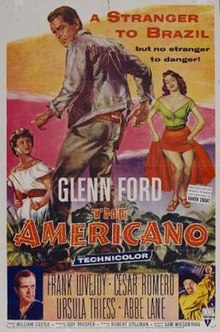The Americano (1955 film)
| The Americano | |
|---|---|
 Theatrical release poster | |
| Directed by | William Castle |
| Screenplay by | Guy Trosper |
| Story by | Leslie T. White |
| Produced by | Robert Stillman |
| Starring | Glenn Ford |
| Cinematography | William E. Snyder |
| Edited by | Harry Marker |
| Music by | Roy Webb |
| Color process | Technicolor |
Production company | Robert Stillman Productions |
| Distributed by | RKO Radio Pictures |
Release dates |
|
Running time | 85 minutes |
| Country | United States |
| Language | English |
| Box office | $1.25 million (US/Canada rentals)[2] |
The Americano is a 1955 American Western film directed by William Castle and starring Glenn Ford.
Plot
[edit]Texas rancher Sam Dent (Glenn Ford) takes a small herd of three Brahman bulls to Brazil, where he has sold them for a small fortune. There, he finds himself in the middle of a range war, as well as in love. Following this, he must find out who are his friends and who are his enemies.
Cast
[edit]- Glenn Ford as Sam Dent
- Frank Lovejoy as Bento Hermany
- Cesar Romero as Manuel Silvera / "El Gato" / Etc.
- Ursula Thiess as Marianna
- Abbe Lane as Teresa
- Rodolfo Hoyos Jr. as Cristino
- Salvador Baguez as Captain Gonzalez
- Tom Powers as Jim Rogers
- Dan White as Barney Dent
- Frank Marlowe as Captain of Ship
- George Navarro as Tuba Masero
- Nyra Monsour as Tuba's Sister
Production
[edit]The Americano began filming in July 1953 in São Paulo, Brazil. Budd Boetticher was initially the director and Clifford Stine the cinematographer. Due to bad weather in Brazil, production stopped in September 1953.[1] Ford refused to return to film and was sued for $1.75 million for breach of contract.[3] Filming recommenced in June 1954 with Boetticher replaced by William Castle and Stine replaced by William Snyder.[1] Abbe Lane's musical number was supervised by her husband, Xavier Cugat.
Reception
[edit]The New York Times found the film interesting but leisurely and predictable, with a heavy Hollywood Western feel despite the exotic setting.[4]
See also
[edit]References
[edit]- ^ a b c The Americano at the AFI Catalog of Feature Films
- ^ "1955's Top Film Grossers". Variety. January 25, 1956.
- ^ "Sues Glenn Ford". Variety. June 2, 1954. p. 2 – via Archive.org.
- ^ https://timesmachine.nytimes.com/timesmachine/1955/01/20/83348412.html?pageNumber=35 'The Americano' Is Set in Texa . . . er, Brazil. The New York Times, January 20, 1955, p. 35.
External links
[edit]- The Americano at the AFI Catalog of Feature Films
- The Americano at IMDb
- Videohound's Golden Movie Retriever 2005 by Jim Craddock


 French
French Deutsch
Deutsch